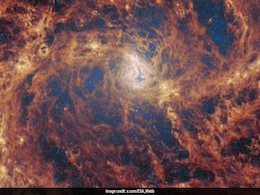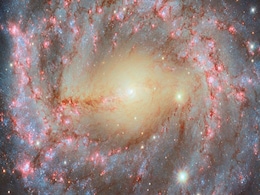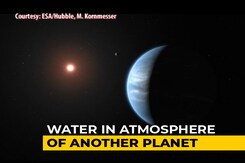Nasa Esa
- All
- News
- Videos
- Web Stories
-

Neighbouring Planets To Faraway Galaxies, NASA Shares Stunning Pics To Celebrate Hubble Telescope's 35th Anniversary
- Thursday April 24, 2025
- Science | Edited by Bhavya Sukheja
To mark the 35th anniversary of the Hubble Space Telescope, the US space agency NASA released new high-definition photos taken with the technological marvel.
-
 www.ndtv.com
www.ndtv.com
-

Signs Of A Supermassive Black Hole Hiding In Nearby Spiral Galaxy
- Friday April 18, 2025
- World News | Edited by NDTV News Desk
Webb witnessed a highly ionised gas whose level of energy was too high to come from something like supernovae, making scientists believe the presence of a supermassive black hole.
-
 www.ndtv.com
www.ndtv.com
-

NASA’s Hubble Space Telescope Shares Detailed Mosaic of the Sombrero Galaxy
- Friday April 18, 2025
- Written by Gadgets 360 Staff
NASA’s Hubble reveals a detailed view of the Galactic favourite, the Sombrero Galaxy, telling about the rare shape of the galaxy. The Sombrero Galaxy is found to have metal-rich stars in its outer region. This research has a future scope of getting deeper insights into its formation by using the advanced imaging technique of Hubble.
-
 www.gadgets360.com
www.gadgets360.com
-

Hubble Captures Stunning Infrared Image of Sh2-284, a Massive Stellar Nursery
- Wednesday March 12, 2025
- Written by Gadgets 360 Staff
Hubble’s latest image of the massive Sh2-284 nebula reveals young stars concealed within thick clouds of gas and dust. Using infrared imaging, astronomers have captured details previously obscured in optical wavelengths. The nebula’s low-metallicity composition provides a glimpse into the conditions of the early universe, shedding light on how ...
-
 www.gadgets360.com
www.gadgets360.com
-

X-ray Signal from Helix Nebula Suggests Planet Was Destroyed by White Dwarf
- Thursday March 6, 2025
- Written by Gadgets 360 Staff
Astronomers have traced decades-old X-ray emissions from the Helix Nebula to a white dwarf possibly consuming planetary debris. Reports suggest a Jupiter-like planet may have been torn apart by the star’s intense gravitational forces. Data from NASA’s Chandra X-ray Observatory and ESA’s XMM-Newton indicate that remnants of the destroyed plane...
-
 www.gadgets360.com
www.gadgets360.com
-

Hubble Captures Stunning Tarantula Nebula Image, Revealing Cosmic Dust and Star Formation
- Thursday February 27, 2025
- Written by Gadgets 360 Staff
A new image from the Hubble Space Telescope highlights the Tarantula Nebula’s complex structure, featuring dense cosmic dust clouds and vibrant star-forming regions. This nebula, located 160,000 light-years away, plays a vital role in understanding stellar evolution. The captured details offer insights into how cosmic dust contributes to star and...
-
 www.gadgets360.com
www.gadgets360.com
-

Hubble’s New Image of Tarantula Nebula Showcases Cosmic Dust and Star Formation
- Tuesday February 18, 2025
- Written by Gadgets 360 Staff
NASA/ESA’s Hubble Space Telescope has captured a breathtaking image of the Tarantula Nebula, located 160,000 light-years away in the Large Magellanic Cloud. The image reveals intricate cosmic dust patterns and active star formation, offering valuable insights into the role of interstellar material in stellar evolution. Researchers are using the d...
-
 www.gadgets360.com
www.gadgets360.com
-

A Star With a Planet May Be Racing Through the Galaxy at Record Speed
- Wednesday February 12, 2025
- Written by Gadgets 360 Staff
Astronomers have identified a potential record-breaking exoplanet system moving at 1.2 million mph. Detected through microlensing, the discovery suggests a low-mass star with an orbiting planet is racing through the Milky Way. Data from the Keck Observatory and ESA’s Gaia satellite indicate a high-speed celestial body that may eventually escape t...
-
 www.gadgets360.com
www.gadgets360.com
-

Hubble Spots Distant Supernova in Gemini, Enhancing Cosmic Distance Studies
- Tuesday February 4, 2025
- Written by Gadgets 360 Staff
The NASA/ESA Hubble Space Telescope has captured a stunning image of SN 2022aajn, a Type Ia supernova in the constellation Gemini. Located 600 million light-years away, the explosion was first detected in November 2022. Type Ia supernovae serve as essential cosmic distance markers due to their predictable brightness. Hubble’s observations, part o...
-
 www.gadgets360.com
www.gadgets360.com
-

SpaceX Falcon 9 Deploys SpainSat NG-1, Enhancing Secure Communications
- Tuesday February 4, 2025
- Written by Gadgets 360 Staff
SpaceX has successfully launched SpainSat NG-1, a next-generation communications satellite, aboard its Falcon 9 rocket. Developed by Hisdesat in collaboration with the European Space Agency (ESA), the satellite is designed to enhance secure governmental communications across Europe. The launch took place from NASA’s Kennedy Space Center, with dep...
-
 www.gadgets360.com
www.gadgets360.com
-

Comet ATLAS Offers Stunning Display as It Nears the Sun
- Friday January 24, 2025
- Written by Gadgets 360 Staff
Comet C/2024 G3 (ATLAS) recently passed within 8 million miles of the Sun, capturing the attention of astronomers. Observed by NASA and ESA’s Solar and Heliospheric Observatory (SOHO), the comet’s tail extended dramatically as it encountered intense solar winds, providing a unique opportunity to study the Sun’s impact on comets. The event, wh...
-
 www.gadgets360.com
www.gadgets360.com
-

ESA Uses Solar Orbiter to Turn Solar Flares into Sound, Offering New Insights
- Thursday January 16, 2025
- Written by Gadgets 360 Staff
The European Space Agency (ESA), in collaboration with NASA, has used data from the Solar Orbiter mission to convert solar flares into audible sound. By mapping solar flare data into blue circles and pairing them with tones, a new way to experience solar activity has been created. This process is linked to the sun’s 11-year solar cycle, with curr...
-
 www.gadgets360.com
www.gadgets360.com
-

NASA Plans Cheaper, Faster Ways To Bring Back Mars Samples By 2030s
- Monday January 13, 2025
- World News | NDTV News Desk
The National Aeronautics and Space Administration (NASA) has planned two new strategies to bring crucial samples from Mars to Earth, aiming for a return by the 2030s.
-
 www.ndtv.com
www.ndtv.com
-

Space Missions of 2025: Lunar Landings, Asteroid Sampling, and More
- Saturday December 28, 2024
- Written by Gadgets 360 Staff
Space exploration in 2025 will see remarkable missions from global agencies like NASA, ESA, China, and Japan. Key initiatives include lunar landings through NASA’s CLPS and Japan’s M2/Resilience, which will test new technologies and study lunar resources. China’s Tianwen-2 mission aims to collect asteroid samples and explore a comet, advancin...
-
 www.gadgets360.com
www.gadgets360.com
-

Hubble Captures NGC 5643’s Spiral Arms, Star Formation, and Hidden Black Hole
- Monday December 16, 2024
- Reported by Gadgets 360 Staff, Written by Gadgets 360 Staff
The NASA/ESA Hubble Space Telescope has captured detailed images of the spiral galaxy NGC 5643, located 40 million light-years away. This grand design galaxy features striking spiral arms outlined by young blue stars and dust clouds, with star-forming regions visible as pinkish hues. Ultraviolet and X-ray studies have revealed an active galactic nu...
-
 www.gadgets360.com
www.gadgets360.com
-

Neighbouring Planets To Faraway Galaxies, NASA Shares Stunning Pics To Celebrate Hubble Telescope's 35th Anniversary
- Thursday April 24, 2025
- Science | Edited by Bhavya Sukheja
To mark the 35th anniversary of the Hubble Space Telescope, the US space agency NASA released new high-definition photos taken with the technological marvel.
-
 www.ndtv.com
www.ndtv.com
-

Signs Of A Supermassive Black Hole Hiding In Nearby Spiral Galaxy
- Friday April 18, 2025
- World News | Edited by NDTV News Desk
Webb witnessed a highly ionised gas whose level of energy was too high to come from something like supernovae, making scientists believe the presence of a supermassive black hole.
-
 www.ndtv.com
www.ndtv.com
-

NASA’s Hubble Space Telescope Shares Detailed Mosaic of the Sombrero Galaxy
- Friday April 18, 2025
- Written by Gadgets 360 Staff
NASA’s Hubble reveals a detailed view of the Galactic favourite, the Sombrero Galaxy, telling about the rare shape of the galaxy. The Sombrero Galaxy is found to have metal-rich stars in its outer region. This research has a future scope of getting deeper insights into its formation by using the advanced imaging technique of Hubble.
-
 www.gadgets360.com
www.gadgets360.com
-

Hubble Captures Stunning Infrared Image of Sh2-284, a Massive Stellar Nursery
- Wednesday March 12, 2025
- Written by Gadgets 360 Staff
Hubble’s latest image of the massive Sh2-284 nebula reveals young stars concealed within thick clouds of gas and dust. Using infrared imaging, astronomers have captured details previously obscured in optical wavelengths. The nebula’s low-metallicity composition provides a glimpse into the conditions of the early universe, shedding light on how ...
-
 www.gadgets360.com
www.gadgets360.com
-

X-ray Signal from Helix Nebula Suggests Planet Was Destroyed by White Dwarf
- Thursday March 6, 2025
- Written by Gadgets 360 Staff
Astronomers have traced decades-old X-ray emissions from the Helix Nebula to a white dwarf possibly consuming planetary debris. Reports suggest a Jupiter-like planet may have been torn apart by the star’s intense gravitational forces. Data from NASA’s Chandra X-ray Observatory and ESA’s XMM-Newton indicate that remnants of the destroyed plane...
-
 www.gadgets360.com
www.gadgets360.com
-

Hubble Captures Stunning Tarantula Nebula Image, Revealing Cosmic Dust and Star Formation
- Thursday February 27, 2025
- Written by Gadgets 360 Staff
A new image from the Hubble Space Telescope highlights the Tarantula Nebula’s complex structure, featuring dense cosmic dust clouds and vibrant star-forming regions. This nebula, located 160,000 light-years away, plays a vital role in understanding stellar evolution. The captured details offer insights into how cosmic dust contributes to star and...
-
 www.gadgets360.com
www.gadgets360.com
-

Hubble’s New Image of Tarantula Nebula Showcases Cosmic Dust and Star Formation
- Tuesday February 18, 2025
- Written by Gadgets 360 Staff
NASA/ESA’s Hubble Space Telescope has captured a breathtaking image of the Tarantula Nebula, located 160,000 light-years away in the Large Magellanic Cloud. The image reveals intricate cosmic dust patterns and active star formation, offering valuable insights into the role of interstellar material in stellar evolution. Researchers are using the d...
-
 www.gadgets360.com
www.gadgets360.com
-

A Star With a Planet May Be Racing Through the Galaxy at Record Speed
- Wednesday February 12, 2025
- Written by Gadgets 360 Staff
Astronomers have identified a potential record-breaking exoplanet system moving at 1.2 million mph. Detected through microlensing, the discovery suggests a low-mass star with an orbiting planet is racing through the Milky Way. Data from the Keck Observatory and ESA’s Gaia satellite indicate a high-speed celestial body that may eventually escape t...
-
 www.gadgets360.com
www.gadgets360.com
-

Hubble Spots Distant Supernova in Gemini, Enhancing Cosmic Distance Studies
- Tuesday February 4, 2025
- Written by Gadgets 360 Staff
The NASA/ESA Hubble Space Telescope has captured a stunning image of SN 2022aajn, a Type Ia supernova in the constellation Gemini. Located 600 million light-years away, the explosion was first detected in November 2022. Type Ia supernovae serve as essential cosmic distance markers due to their predictable brightness. Hubble’s observations, part o...
-
 www.gadgets360.com
www.gadgets360.com
-

SpaceX Falcon 9 Deploys SpainSat NG-1, Enhancing Secure Communications
- Tuesday February 4, 2025
- Written by Gadgets 360 Staff
SpaceX has successfully launched SpainSat NG-1, a next-generation communications satellite, aboard its Falcon 9 rocket. Developed by Hisdesat in collaboration with the European Space Agency (ESA), the satellite is designed to enhance secure governmental communications across Europe. The launch took place from NASA’s Kennedy Space Center, with dep...
-
 www.gadgets360.com
www.gadgets360.com
-

Comet ATLAS Offers Stunning Display as It Nears the Sun
- Friday January 24, 2025
- Written by Gadgets 360 Staff
Comet C/2024 G3 (ATLAS) recently passed within 8 million miles of the Sun, capturing the attention of astronomers. Observed by NASA and ESA’s Solar and Heliospheric Observatory (SOHO), the comet’s tail extended dramatically as it encountered intense solar winds, providing a unique opportunity to study the Sun’s impact on comets. The event, wh...
-
 www.gadgets360.com
www.gadgets360.com
-

ESA Uses Solar Orbiter to Turn Solar Flares into Sound, Offering New Insights
- Thursday January 16, 2025
- Written by Gadgets 360 Staff
The European Space Agency (ESA), in collaboration with NASA, has used data from the Solar Orbiter mission to convert solar flares into audible sound. By mapping solar flare data into blue circles and pairing them with tones, a new way to experience solar activity has been created. This process is linked to the sun’s 11-year solar cycle, with curr...
-
 www.gadgets360.com
www.gadgets360.com
-

NASA Plans Cheaper, Faster Ways To Bring Back Mars Samples By 2030s
- Monday January 13, 2025
- World News | NDTV News Desk
The National Aeronautics and Space Administration (NASA) has planned two new strategies to bring crucial samples from Mars to Earth, aiming for a return by the 2030s.
-
 www.ndtv.com
www.ndtv.com
-

Space Missions of 2025: Lunar Landings, Asteroid Sampling, and More
- Saturday December 28, 2024
- Written by Gadgets 360 Staff
Space exploration in 2025 will see remarkable missions from global agencies like NASA, ESA, China, and Japan. Key initiatives include lunar landings through NASA’s CLPS and Japan’s M2/Resilience, which will test new technologies and study lunar resources. China’s Tianwen-2 mission aims to collect asteroid samples and explore a comet, advancin...
-
 www.gadgets360.com
www.gadgets360.com
-

Hubble Captures NGC 5643’s Spiral Arms, Star Formation, and Hidden Black Hole
- Monday December 16, 2024
- Reported by Gadgets 360 Staff, Written by Gadgets 360 Staff
The NASA/ESA Hubble Space Telescope has captured detailed images of the spiral galaxy NGC 5643, located 40 million light-years away. This grand design galaxy features striking spiral arms outlined by young blue stars and dust clouds, with star-forming regions visible as pinkish hues. Ultraviolet and X-ray studies have revealed an active galactic nu...
-
 www.gadgets360.com
www.gadgets360.com



















